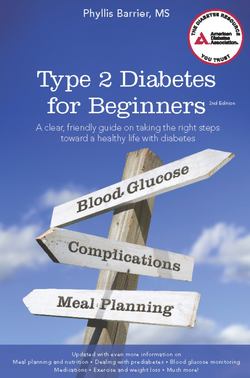Читать книгу Type 2 Diabetes for Beginners - Phyllis Barrier - Страница 5
Оглавление—2—
Type 1 and Type 2 Diabetes: What’s the Difference?
There are many types of diabetes, but the two most common are type 1 and type 2 diabetes. Diabetes means that your blood glucose is too high.
Everyone’s blood has some sugar in it because your body needs sugar for energy. Our brain can only work if it has blood glucose. But too much glucose in your blood—too much sugar—can mean you have diabetes. Normally, your body breaks food down into glucose and sends it into your bloodstream. Then your pancreas (PAN-kree-us) makes a hormone called insulin (IN-suh-lin). Insulin’s job is to help get the glucose from the blood into your body’s cells, where it can be used for energy. Insulin helps keep blood glucose in a normal range.
In type 1 diabetes, the pancreas makes little or no insulin. People with type 1 diabetes get insulin from a shot or a pump to keep their blood glucose in their target range. Most people with type 1 diabetes take two to four shots a day or use an insulin pump. Old names for type 1 diabetes are juvenile-onset diabetes or insulin-dependent diabetes. Type 1 diabetes is not as common as type 2 diabetes.
People with prediabetes or type 2 diabetes still make insulin. But their pancreas may not be making enough, or their body may not be using it the right way. People with prediabetes or type 2 diabetes can manage their condition by watching what they eat, by being more active, and sometimes by taking diabetes medicines. Old names for type 2 diabetes are “maturity-onset diabetes” or “adult-onset diabetes,” but now kids are getting type 2. Type 2 diabetes is the most common type of diabetes.
Kids who are overweight and aren’t active are more likely to get prediabetes or type 2 diabetes. So are kids who have a family member with diabetes. Some racial and ethnic groups have a greater risk of getting diabetes: Native Americans, African Americans, Hispanic Americans (Latinos), Asian Americans, and Pacific Islanders.
Today everyone knows someone who has diabetes. It may be a family member, like your mother, your aunt, or your child. Or it may be a coworker or good friend. When I worked for the American Diabetes Association, I always carried my American Diabetes Association work bag when I traveled on an airplane. Every single time, someone on the plane would talk to me about diabetes. They talked about their grandchild’s diabetes, about their brother’s diabetes, or about their own diabetes.
Diabetes is serious, and more people are getting it. By taking care of your diabetes and showing others how to do it, you may prevent people you love from getting diabetes. You can be a role model for people around you.
People with type 1 or type 2 diabetes do some of the same things to care for their diabetes. They watch what they eat, they are active, and they check their blood glucose levels using a meter. But we’ll learn more about all of that in later chapters in this book.
Blood Sugar vs. Blood Glucose
You may have heard people talk about their sugar when they talk about diabetes. Your doctor or another member of your diabetes health care team may talk to you about blood sugar or blood glucose. Blood sugar and blood glucose are the same. In this book, I’ll use blood glucose when talking about the amount of sugar or glucose in your blood.
